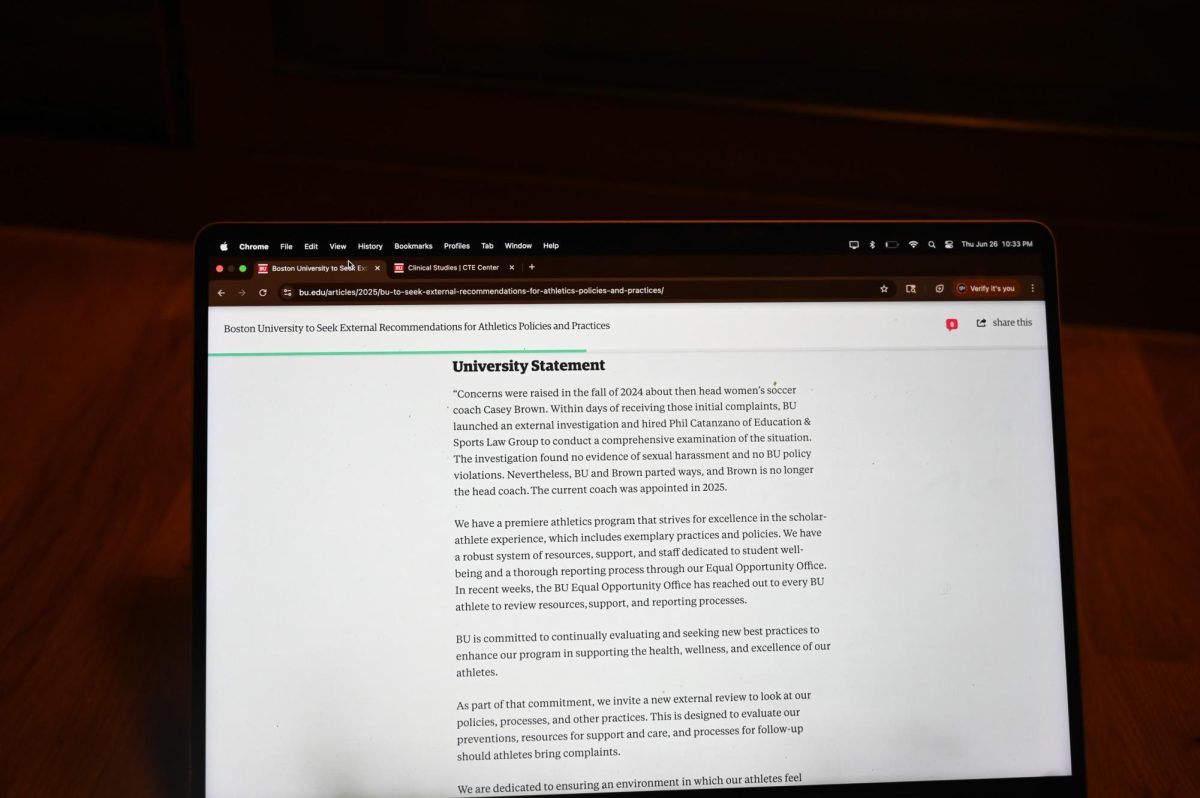An array of racing medals hangs from two small posts overlooking a stationary bike and treadmill in a small, compartmentalized, pepper-red room in Joshua Gordon’s two-story apartment.
Gordon, a law student at Suffolk University, often runs upward of 18 miles at a time on this treadmill — 95,040 feet to be precise.
Below the mirror leans a framed essay titled, “Why do I run?” by George Sheehan, one of Gordon’s professed running heroes.
“I want to see how far my body can go and how fast I can ultimately run,” Gordon said.
For the elite athlete or the novice runner, marathon running requires both physical and mental preparation along with good nutrition, adequate health, and a drive to push the human body beyond its physical limitations.
SOME TRENDS ARE NOT
FOR EVERYONE
“Running is a new social phenomenon in our country,” said Jack Fultz, who won the 1976 Boston Marathon.
Fultz, who now works as an athletic consultant while teaching sports psychology at Tufts University, designs training programs for many first-time marathoners.
“There is a whole new breed of marathoner who wouldn’t even have considered running something like a marathon,” said Fultz, who also trains runners sponsored by the Dana Farber Cancer Institute. “In the past, people ran if they were exercise junkies. The marathon held the ultimate challenge for them.”
Now, according the Fultz, people are running to raise money for nonprofit organizations or to recover from a recent loss or tragedy.
“A lot of these people are coming into marathoning from a different perspective and a different motive,” Fultz said. “The notion of running a marathon and raising money can be a very empowering experience for them.”
Yet, according to Arun Ramappa, an orthopedic surgeon at Beth Israel Deaconess Medical Center, not everyone is cut out to run a marathon.
“There are different degrees to how well someone is anatomically designed to running,” Ramappa said.
“Running taxes all of our muscles, tendons, ligaments, bones and cartilage,” he added. “It is a great deal of impact that the body experiences when running such distances.”
Ramappa said certain people have “biomechanical abnormalities” that greatly increase the risk of injury.
These abnormalities include knee or joint problems and other skeletal alignment issues.
“Our bodies are not necessarily designed to run such long distances,” Ramappa said.
Training, Ramappa said, is the most important aspect of running a successful marathon.
“Marathon running is not something to be taken lightly,” he said. “You have to train extremely well and prepare well. The people who prepare well for it are most likely to limit their risk.”
Shin splints, iliotibial band syndrome, plantar fasciitis, patello-femoral syndrome and other repetitive stress injuries are some of the most common problems encountered by runners, Ramappa said.
Yet, more serious problems, including stress fractures or bone density depletion, can also result from running.
“If you can’t run, you can’t run,” Ramappa said. “If you have poor mechanics, it will be revealed relatively quickly.”
MARATHON BOOT CAMP
Clint Verran is a professional marathoner. He runs more than 160 miles a week.
Yesterday Verran finished 10th in the Boston Marathon. In 2002, he finished 17th. He also competed numerous other races, including the 2004 United States Olympic Trial Marathon and the 2005 International Association of Athletics Federations World Championships Marathon in Helsinki, Finland.
In his free time, Verran, the Lake Orion, Mich. native is a physical therapist and running coach, working with both novice and advanced runners.
According to Verran, there are varied approaches to marathon training, but the best preparation is simply to run.
“There is a saying that if running ain’t enough, then you ain’t running enough,”
Verran said.
“If the primary goal is to improve running, then they need to do nothing else then go out there and run more miles,” Verran added.
Stretching, Verran said, is important to prevent injury, but the best way to improve running is to keep adding mileage.
“Someone who runs, say, three times a week and logs 10 miles a week, if they double that, they will see a major return on their investment,” he said.
Verran said other programs incorporating cross training are “easier to sell” because they appear more enjoyable.
Fultz said cross training is an important part of marathon preparation.
“These first timers, we bring them along more slowly,” Fultz said. “We encourage them to do alternative forms of training.”
But Fultz, who has run approximately 40 marathons and now suffers from arthritis in his hips, said he regrets not incorporating more variety into his training regimens.
According to Noel Vigue, a strength and conditioning coach at Boston University, marathon training is about building a good foundation.
“We like to work from the inside out,” Vigue said. “Stabilizing a person’s spine, strengthening muscles around the spine, core musculature and supporting structures.”
Identifying parts of the body that are not balanced, Vigue said, is important to make a person stronger and increase mobility.
“We don’t have to make a person a gymnast or a body builder,” he said. “We have to make sure everything is in balance and make sure their body is in a functional state.”
During the first few months of training, Vigue stresses heavy cross training, including biking, swimming and walking.
“It is all about progression,” Vigue said. “If you don’t progress properly, the person might be miserable.”
NO REST FOR ELITE RUNNERS
One week before the Boston Marathon, Verran and his teammate Brian Sell left their homes in Michigan and flew south to Florida for training.
Over the past several years, marathon day in Boston has been unusually warm, so the two teammates decided to give themselves a dose of Florida’s 90-degree heat just in case history repeated itself.
“The big thing was to get heat acclimated,” Sell, who placed fourth in this year’s marathon. “Because Boston has been pretty hot in the past.”
For most runners, the week before a marathon is for complete rest and relaxation, allowing their bodies to prepare for the 26.2 mile race to come.
But, for elite runners like Verran and Sell, the week before a marathon is spent just like any other week of training — running.
“I will still run about 110 miles,” Sell said. “Most of us, we are up to over 140 and 150 miles a week, so I will taper off down 40 miles or so.”
“The day before we are only going to do six or eight miles,” he added.
Elite runners, rarely, if ever, take a day off. Their weeks are filled with carefully planned runs; each specifically designed to groom their bodies for maximum performance.
Marathoners typically divide their days between long endurance runs and short, intense interval workouts and hill training, Verran said.
Elite runners, Verran said, also do what is called fartlek training, Verran said. Fartlek, which means “speed play” in Swedish, is similar to interval training but is less structured with no set speed or distance.
According to Verran, the hardest workout comes two weeks before the marathon when he and his teammates run two six mile intervals at a pace of 4.55 minutes per mile.
“The elite runner has the ability to go out and race the marathon at a faster pace than he or she normally trains at,” Verran said. This is what separates the weekend warriors from the elite.”
THE MENTAL MARATHON
Sell literally could not get the Boston Marathon off of his mind.
“It basically has been the first thing on my mind when I wake up for the last three months,” Sell said. “I am preparing for the absolute worst and hoping it is not that bad.”
For many runners, both elite and pedestrian, running 26.2 miles can be as much, if not more, of a mental challenge than a physical challenge.
According to BU sports psychologist Adam Naylor, it is essential to “know how your body and mind are going to respond” when preparing for a race.
“Expect the unexpected,” Naylor said
Naylor added it is important to devise a strategy for the middle of the race, which often is the most physically and mentally challenging part.
These support systems include friends and family to cheer a runner, Naylor said, along with the runner’s ability to ignore any pain he may be feeling by simply focusing on something external, like the weather or nature.
Elite runners, Naylor said, will be concentrating on their body while watching their split times.
“Usually I break the marathon down into different, smaller portions,” Verran said. “Just to look at it as one event at 26 miles long is overwhelming.”
According to Fultz, it is important to disengage your conscious mind during a race, and let your subconscious take over.
“The conscious mind harbors all of our negative emotions, doubts and fears,” Fultz added. “The subconscious mind is the doer.”
PHYSIOLOGY OF RUNNING
According to Steven Lewis, a professor of health sciences at BU, the simplest explanation behind how humans run involves brain activity.
“Your brain sends signals that tell your muscles to start moving,” Lewis said.
Yet, the physiological elements required for marathon running extend far beyond brain waves.
Human beings, Lewis said, generally have two main types of muscle fibers found throughout the body. One type of fiber is called fast twitch, and the other type is called slow twitch.
Everyone has a mixture of both fibers, but some people have more of one type than the other.
Sprinters usually have more fasttwitch fibers, while marathon runners have a higher percentage of slow-twitch fibers.
Fast-twitch fibers contract more rapidly but are only able to perform for short periods of time, Lewis said.
In contrast, slow-twitch fibers contract slowly but can function over long periods of time due to their ability to transport and use oxygen while experiencing little fatigue, Lewis said.
Another genetic factor determining marathon success is bone structure.
Kenyans and Ethiopians, for example, have had high success rates in marathons due to their small, light bone structures, Lewis said.
“If you are light and you don’t have heavy bones to carry around, it is a big factor,” Lewis said. “And if you have a big heart and strong cardiovascular system, you have the capacity to be a good runner.”
According to Verran, the left ventricle of an elite runner’s heart can pump up to three times as much blood as an average heart, while the overall thickness of the heart’s wall is three to four times greater than the normal heart.
“Marathon runners have an extremely well-adapted cardiovascular system,” Verran said.
Professional marathoners, he added, also have body fat percentages around 7 percent or lower.
But, even if an individual is not genetically adept for running, the human body can adapt and become more suited for the sport.
According to Fultz, running improves an individual’s circulatory system.
“The body literally creates new capillaries to reach deeper areas of the muscular system so it can fuel muscle fibers that are now being recruited,” Fultz said. “Whereas they were not prior to this advanced training.”
A runner’s body, Vigue said, also uses energy more efficiently.
“You are starting to utilize and train your body to become very very efficient in its energy stores and energy system demands,” Vigue said. “It will be very good at utilizing and breaking down fat.”
The body will also transport more oxygen, Vigue said.
“You are challenging the system to do more than it is use to,” he said. “You are requiring more and more red blood cells to do their jobs, more and more oxygen to get to muscles and more and more waste to be taken away and converted to lactic acid.”
Verran, who has been running since high school, said the sport has not aged his body.
“I am 30 years old and my body really hasn’t changed from when it was 18,” he said. “I feel the same physically as I did when I was 18 years old and that is a hard thing for a lot of people to say.”


















































































































